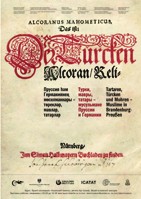
Peoples of the World: The exhibition "Turks, Moors, Tatars - Moslems of Prussia and Germany" in the Kazan Kremlin
The exhibition "Turks, Moors, Tatars - Moslems of Prussia and Germany" was opened in the Museum-Reserve "Kazan Kremlin".
This is the first exposition, presented in the framework of the long-term international research project "Tatar materials in foreign archives", which is leading by the Sh. Marjani Institute of History of the Academy of Sciences of the Republic of Tatarstan. The museum-preserve first presents exhibits from eight institutions in Germany: museums, archives, libraries and private collections.
Visitors will see more than 150 exhibits that were not exported outside Germany and for the first time in Russia are represented in the Kazan Kremlin. These exhibits reflect earlier little-known or even unknown pages of the relationship of Christians and Muslims in Germany in the XV-XX centuries. All contacts of the Germans with another, Muslim civilization have found their reflection in science, culture and everyday life. For 600 years, the Turks and Tatars belonged to the defining role in the history of acquaintance of the inhabitants of Germany with the Muslim East.
The exhibition presents the history of the Tatars aimed at serving the Prussian army in cavalry regiments (since 1675) by Peter I and Catherine I. For the first time it will be possible to see the diplomatic letters of the Crimean khans recently found in the Prussian State Archives to Prussian rulers and reciprocal messages from the Prussian court to the Crimea, showing the friendly nature of relations between countries and the international recognition of the Tatar statehood.
The exhibition also features portraits of Kazan Tatars (imam and rich city dweller) unknown earlier, made from nature by a German ethnologist and traveler V. Kizivetter, during his stay in Kazan in 1842.
Among the unique exhibits of the exhibition there are the first German editions of the Koran and its translations, manuscript diaries of travelers, "The History of the Ottoman Empire…" by Dmitry Kantemir, rare lithographs and engravings, as well as the living voices of Tatar prisoners of the First and Second World Wars.

